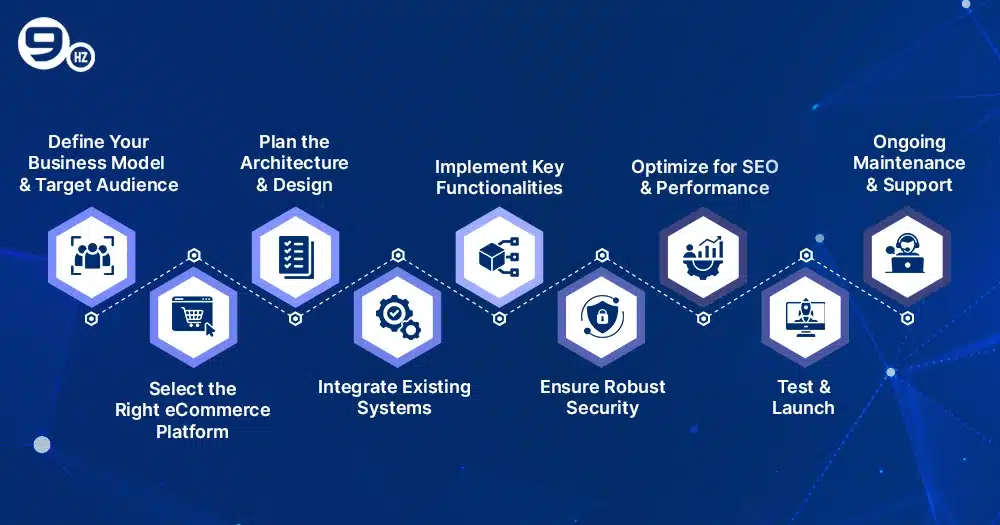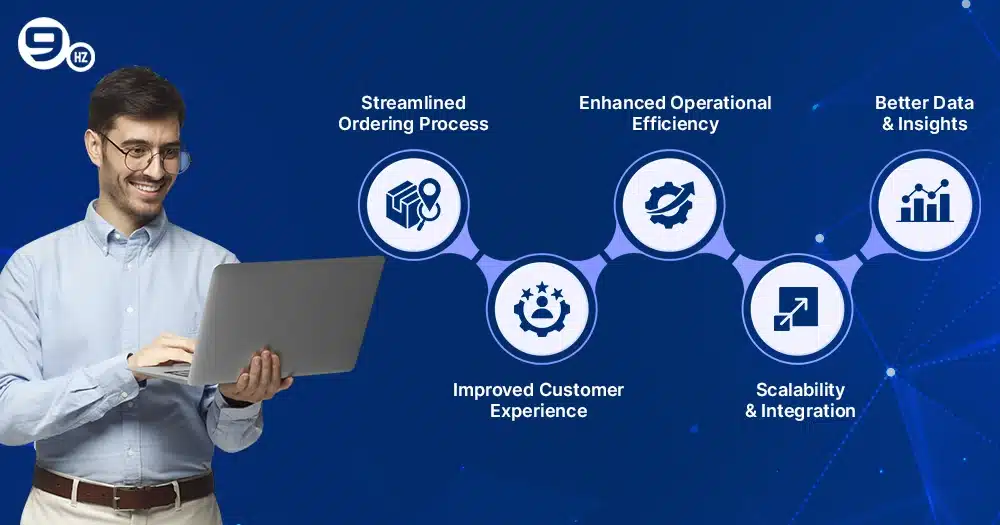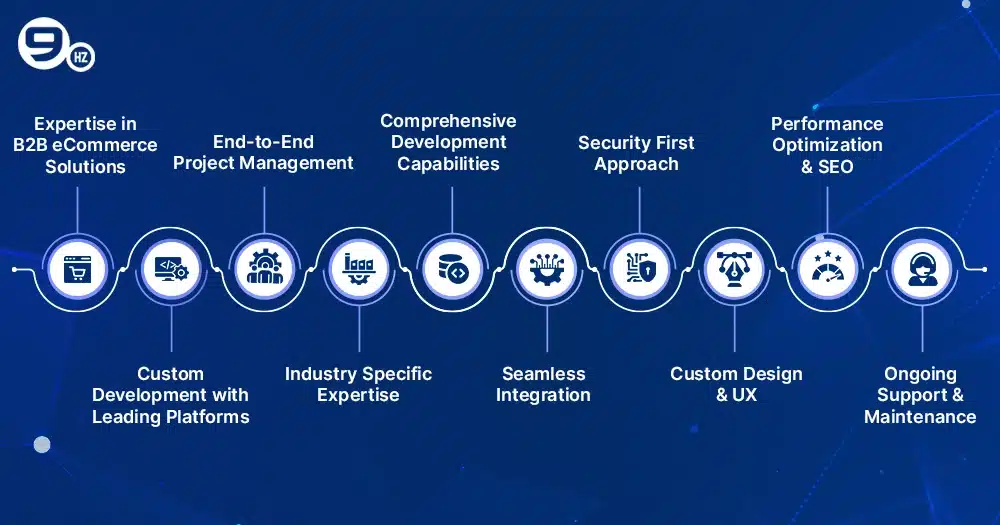Imagine if the possibility existed to triple your business reach just by upgrading your website. Any sooner or later, B2B eCommerce will no longer be a trend but a necessity of the digital era. Forrester has predicted that B2B eCommerce sales in the United States may hit $3 trillion by 2027 as buyers favor digital self-service and smooth online shopping experiences. If you are working on a B2B eCommerce website that will attract potential customers and improve operational efficiency, you are indeed on the right path.
Whether you are making the upgrade to an already existing online store or setting up a brand-new B2B eCommerce platform, knowing the B2B eCommerce website development process will prove very beneficial in satisfying your company’s objectives. This detailed step-by-step guide will help you during each phase, from planning and execution to the delivery of a user-friendly interface with a robust security protocol and seamless integration with your business.
Let us examine what B2B eCommerce development is all about and how to create an online business that will please your business clients and take your venture to new heights.
What Is B2B eCommerce Website Development?
B2B eCommerce website development is all about building an online store in which transactions are conducted between businesses, commonly known as business-to-business commerce. These kinds of platforms serve the business client rather than the individual consumer and often involve a more complicated buying process, custom pricing models, and integration with enterprise tools. More than just a website, a B2B eCommerce site shall have:
- The system integrates with inventory management systems, Customer Relationship Management (CRM), and Enterprise Resource Planning (ERP) tools.
- We calculate complex prices for various customer groups.
- A secure payment gateway is necessary to protect customers’ sensitive information.
- Responsible for managing large transactions and providing options for payments.
- The system provides mobile compatibility to enhance the customer experience.
- Some other features are self-service, advanced search, and personalized recommendations.
Simply put, B2B eCommerce development is how you introduce ease in business purchases between two businesses while meeting their specific business needs and expectations.
What’s the Difference Between B2C and B2B eCommerce Website Development?
B2B eCommerce website development aims to create platforms where bulk ordering, tiered pricing, account-based access, and complex workflow occur. These sites will generally need integrations with ERP, CRM, and inventory systems as a requirement to handle the operational flow.
Paradoxically, Business to Consumer (B2C) websites cater to individual consumers and focus on quick checkout, attractive visuals, and easy navigation. Even if both types of platforms need responsive design and SEO building, B2B platforms prefer more adjustments and features adapted to business buyers’ needs.
| Feature | B2C eCommerce | B2B eCommerce |
|---|---|---|
| Target Audience | Individual consumers | Business clients, buyers, and other businesses |
| Pricing Model | Fixed pricing | Tiered or custom pricing |
| Transaction Volume | Low to moderate | High-value and bulk orders |
| Checkout Process | Simple and quick | Multi-step, approval-based, sometimes with purchase orders |
| Required Integrations | Basic (e.g., payment, shipping) | Complex (ERP, CRM, inventory, supply chain) |
| Payment Options | Credit/debit cards, wallets | Invoicing, net terms, ACH transfers, and credit lines |
| Buyer Journey | Shorter, emotionally driven | Longer, based on logic and business goals |
One of the most significant differences is in the purchasing process. While B2C customers do the impulse buys, business buyers require detailed information, bulk pricing, and approval workflows. Therefore, we expect B2B websites to function seamlessly across intricate touchpoints.
Pro Tip: Use analytics to understand your customers and thereby customize experiences for different business connections.
B2B eCommerce Website Development
Plan well, make the merging smooth, and really think about what your business clients want when you’re building a great B2B eCommerce site. Unlike eCommerce sites for consumers, B2B platforms need to be able to handle a lot of complicated business processes involving big sales and/or packages with many decision-makers. Here is a step-by-step guide to building a B2B eCommerce website:
1. Define Your Business Model and Target Audience
The first thing you need to do is choose the type of business plan you want to use: live sales, distribution, or manufacturing. Next, figure out who your target audience is by looking at their business, order size, buying habits, and expectations. You should be able to decide what features, materials, and functions are most important to your users based on what you’ve learned so far.
Tip: Making a map of the whole customer journey lets you create the platform in a way that makes customers happy from the time they find it until they leave it after buying something.
2. Select the Right eCommerce Platform
Pick a tool that works with business-to-business ecommerce transactions. Magento, BigCommerce B2B Edition, and Shopify Plus are a few examples. With these systems, you can set your prices, offer open payment terms, and make it easy for your products to work together. To make shopping easy for your B2B customers, it must also be able to grow with your business and meet their specific needs.
3. Plan the Architecture and Design
Design the website to have a sleek, mobile-responsive user interface, optimal site architecture, fast load times, and easy-to-use navigation. Ensure your B2B website is optimized for business functionality if you wish to retain and improve customer engagement and the ease with which they are able to shop.
Optimal functionality results in customer bliss when attempting to shop on a B2B website, furthering your business’s support of customer engagement, customer satisfaction, and ability to meet business goals and objectives.
4. Integrate Existing Systems
Extend your new B2B website to integrate ERP, CRM, inventory management, and supply chain systems, which will serve as efficiency measures to enhance support for both current and potential customers. While ideally, business applications will seamlessly integrate with each other.
These features will eliminate the guesswork typically expected of employees taking orders, automatically update inventory and stock levels. Reduce personalization with single-sourcing, and allow the B2B environment to grow and develop. Improved integration is meant to streamline workflows, reduce operational errors, and provide businesses tools to simplify integration of transactions and to better fulfill customer demand.
5. Implement Key Functionalities
The addition of key features (advanced search tools, secure payment systems, role-based tools, etc.) is made for the purpose of ensuring the client experience is unhindered, customer data is secured, and there is a streamlined business process for customer groups. You will require features for all of the following:
- The advanced search feature allows users to filter results by SKU/item, category, or bulk pricing.
- Secure payment systems to protect sensitive customer data.
- Tools are available to facilitate the management of quotes and multi-user accounts.
- We facilitate workflow approvals and purchase orders.
- Access-controlled dashboards for different customer groups.
6. Ensure Robust Security
The significant transactional and sensitive data involved in B2B transactions make security an absolute must. SSL encryption, firewalls, and staff regularly conducting audits will assist in providing customer data and transaction safeguards.
Good practices around security build trust between buyers and sellers, as well as compliance with regulations, and safeguard your company against possible data breaches and other cyber threats, therefore enabling one to do business safely online.
7. Optimize for SEO and Performance
Practicing search engine optimization will drive visibility and sales. You want to follow best practices such as using target keywords and optimizing your content and site architecture. You want to optimize your site speed as much as possible.
This can include compressing images, enabling cache, and limiting script usage to enhance website performance. These steps will enhance the user experience, load times, and overall ranking of your site on search engines and ultimately will help you attract more customers for potential leads.
8. Test and Launch
Finally, you want to test the site to ensure usability, function, and security prior to launch. Test the site on multiple devices and browsers to confirm a seamless experience. Obtain feedback from actual clients to see if it performs as needed and if it meets their needs. Such feedback will minimize issues that would impede user experience after a launch.
9. Ongoing Maintenance and Support
When all initial launch items have been accomplished, it’s time to act to maintain the ongoing upkeep, updates, and support required for customers to use your new B2B eCommerce website. Monitor your customers’ activity consistently and follow how they use continuous improvement data after an eCommerce website launch.
Just as you would provide ongoing technical support for a business customer, you want to be sure the website is secure, optimized for web applications, and compliant with any changing business needs. With everything working, you can be confident you can continue meeting customer expectations, improve site functionality, and keep yourself competitive.
What Are Some B2B eCommerce Must-Have Features?
B2B eCommerce websites need to consider more than the basic functionality to meet the needs of business consumers. B2B eCommerce involves creating a simpler purchasing process, fulfilling complex B2B processes, enhancing the customer experience, ensuring data protection, and driving online sales. Below is a short list of required features your B2B eCommerce website should consider in order to remain competitive when scaling.
1. Custom Pricing and Bulk Discounts
B2B eCommerce websites allow you to provide tailored pricing based on different customer groups that represent the business’s enterprise value. This will assist you to drive more repeat orders and help support business customers real business models through dynamic pricing opportunities, ordering in bulk, and contract buying options.
2. Quick Order and Reordering Tools
To assist in making the purchase ordering experience easier for business consumers, you can provide a quick order form and one-click reorder. These tools support operational efficiency and help customers place orders while also alleviating the need to backfill their inventory levels through the ecommerce website.
3. Advanced Search and Filtering
Advanced search capability with SKU, category, and price filtering enables the user to experience a faster product search. This experience greatly enhances the shopping experience while offering businesses a better understanding of their customers’ shopping patterns.
4. Multi-User Accounts and Role-Based Access
To better understand control, enable business clients to assign roles and permissions within a single account. This functionality demonstrates the ability to accommodate complex business processes and typically aligns with common B2B ecommerce website development.
5. Integration with Business Systems
Having the capability to seamlessly integrate with ERP, CRM, and inventory management systems ensures that business clients can operate smoothly and have immediate access to customer information and product availability.
6. Secure Checkout and Payment Options
Secure payment gateways and payment options (for example, Janam net terms and ACH payment) not only establish trust and eliminate unnecessary work, they also protect customer-sensitive information during a transaction.
7. Responsive Design for Mobile Devices
As the use of mobile phones continues to rise, having a user-friendly interface and fully responsive design provides customers with an interface that is consistent across multiple screens and platforms, delivering better overall experiences.
8. Self-Service Features
Providing clients access to a self-service portal and the ability to manage their orders, track shipments, and access invoices eliminates work for your support team while increasing long standing customer satisfaction.
9. Personalized Recommendations
Offer tailored suggestions based on artificial intelligence using preferences, past purchases, and user behavior. Customized suggestions are a great tool for increasing online sales and fostering consumer loyalty by means of a unique experience.
10. Reliable Hosting Provider
Not least of all, choose a reputable hosting company. Your site has to be scalable, safe, and speedy. Good hosting helps to preserve private client data, increase the speed of your ecommerce website development, and guarantee uptime.
Pro Tip: Constantly updating your platform according to analytics can help you better understand user behavior and boost consumer loyalty!
Key Benefits of B2B eCommerce Website Development
There are many benefits associated with B2B eCommerce website development that can help manufacturers, wholesalers, and distributors improve their operations and profitability. Here we delve into the key benefits that show why B2B businesses should embrace digital transformation.
1. Streamlined Ordering Process
Above all, automation sticks out as one of the greater benefits. Automation allows buyers to place bulk orders, view custom-tiered pricing based on orders, and view their purchase history without the manual effort. Automation can help businesses eliminate mistakes, save time, and improve order accuracy.
2. Improved Customer Experience
Traditional B2B commerce does not offer buyers eCommerce components such as self-service portals, real-time inventory updates, and personal product recommendations. Physical B2B commerce does not meet buyer expectations or help maintain loyalty by offering a more seamless and responsive experience.
3. Better Data and Insights
Many modern eCommerce platforms like Magento or Shopify Plus have advanced reporting, customer analysis, and other in-depth analytics. By leveraging this data, we can convert site traffic to sales. We can analyze customer behavior, evaluate sales trends, and create targeted marketing efforts in a systematic way.
4. Scalability and Integration
Website design in the B2B space today must accommodate growth. As business changes arise, from adding product lines to opening new markets, platforms like BigCommerce B2B Edition are built to scale, often supporting incremental growth without disruption to business operations. Programmatic integrations with ERP, CRM, and supply chain systems can assist in the same degree of operational efficiency, supporting real-time approaches to business data.
5. Enhanced Operational Efficiency
B2B eCommerce website development directly reduces manual work and frees up employees to perform other critical work. By automating the process of creating invoices, managing inventory, and communicating with customers, employees can eliminate redundancies.
Moreover, they overlap in operational tasks with seamless integrations into the backend of the business. The end-user gets real-time operational updates, and businesses support lower operational costs through automation. In the end, this translates to reduced time to fulfillment, clearer and operationally accurate delivery, and a more agile supply chain.
Why Choose The NineHertz For B2B eCommerce Website Development?
The partner you choose for B2B eCommerce website development will determine the success of your digital revolution. Using strategy, technology, and thorough industry knowledge and experience, we at The NineHertz provide e-commerce solutions targeted at unified business operations, increased consumer pleasure, and alignment with your long-term company objectives.
1. Expertise in B2B eCommerce Solutions
With years of experience in B2B eCommerce website development, NineHertz understands the complexity of business-to-business operations. Through bulk ordering, custom pricing for every customer, and building custom solutions for your unique business needs.
Our team knows the B2B ecommerce website development process that will help you achieve your business objectives. Having experienced industry professionals on our team means we can build your business’s eCommerce platform with the knowledge to ensure your site is scalable and adaptable to changing market demands.
2. Custom Development with Leading Platforms
At The NineHertz, we use facilities in custom development on ecommerce platforms such as Magento, BigCommerce, and Shopify Plus to build or enhance your business operations. Whether it’s advanced integrations or a fully custom buying experience, our skilled developers can build a high-performing, flexible B2B eCommerce website that means you get a solution that handles complex purchases while being easy to use for clients.
3. End-to-End Project Management
The NineHertz offers project management for B2B website development from initial planning through to support after launch. We take a collaborative approach, working with you and your stakeholders on each phase of the project.
For example, design planning, development, testing, and internal deployment, ensuring each step is aligned with milestones and objectives. This all-inclusive service model ensures that your experience is smooth and streamlined, saving time and ensuring the final product is satisfactory and beyond your expectations.
4. Industry Specific Expertise
First of all, we acknowledge that every business-to-business model is different. Every one of our solutions will be tailored to your particular consumer base, sector, or industry, and the company needs to guarantee that you are actively expanding and scaling.
5. Comprehensive Development Capabilities
We create for you an integrated smartphones ecommerce website with secure access and advanced functionality through supply chain management processes—mobile-enabled workflows. From planning to deployment, we ensure unmatched performance customization.
6. Seamless Integration
Unlike our competitors, we distinguish ourselves by enhancing operational performance through faster order fulfillment, achieved by accurately integrating customer relations, ERP, and inventory management tools for automation.
7. Security First Approach
Sensitive customer details in the digital sphere requires maximum security. We implement firewalls, schedule security audits, and use SSL to encrypt sensitive information, ensuring data integrity and gaining customers’ trust.
8. Custom Design and UX
For all mobile devices, we visually design and build responsive websites, ensuring clients and customers move seamlessly across diverse targets and user behavior, which guarantees seamless sailing.
9. Performance Optimization and SEO
Advanced tuning of website performance coupled with SEO ensures that potential clients are directed to your website on every and any search engine and improves online shopping experiences.
10. Ongoing Support and Maintenance
We flex after launch. Having no last button that is integrated into maintained platforms offered alongside continuous maintenance, updates, and provided technical support allows clients to mold their platform based on user and evolving business market behavior.
Conclusion
Successful navigation of the modern digital terrain we live in depends on launching your own B2B eCommerce website. Emphasizing important elements like bespoke pricing, safeguarded payment channels, and smooth connection with your company can help you create an ecommerce platform that satisfies your medium- or long-term development goals as well as those of your business clients.
We have walked you through the many phases of investigating and building a B2B site via this tutorial. We have separated the variations between both websites and justified why The NineHertz is well-known for maximizing ecommerce website solutions. With a strong idea and the correct partner like The NineHertz, you can create a solution that future-proofs your online company and enhances your purchase process.
Act immediately and call The NineHertz to realize your online store vision right now if you are ready to brighten your B2B eCommerce platform and witness actual benefits for your company.
FAQs About B2B eCommerce Website Development
1. How much does it cost to create a B2B website?
The average cost to build a B2B website is between $10,000 and $50,000 for basic sites and more than $100,000 for projects that are more involved and require essential features or integrations. Keep in mind that you will have future costs for maintenance (hosting) and updates as well for continued success.
2. What are some examples of successful B2B eCommerce websites?
Here are some good examples of successful B2B websites: Amazon Business, Grainger, and Alibaba. These companies are among the big players in the B2B space. Their websites are user-friendly and effective, have no issues with the user’s procurement process, and provide solid functionality to businesses and the customer experience with specific industry needs.
3. Which eCommerce platform is best for B2B?
Top B2B eCommerce platforms include Magento (this platform is very flexible and robust), Shopify Plus (these sites have extensive customer tools for management and are very easy to use), and BigCommerce (best for businesses looking for complex transactions and customizations). Ultimately, you must choose for your unique business needs.













